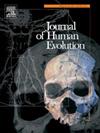觅食种群生长过程中髂骨形态的变化
IF 3.1
1区 地球科学
Q1 ANTHROPOLOGY
引用次数: 0
摘要
人类骨盆形态经常被描述为两足动物、脑化和产科学之间的进化妥协;然而,最近的研究表明,骨盆的生物可塑性比之前认为的要大。成年现代人群中存在骨盆形态的变异,但影响这种变异的因素,以及在生长过程中何时表现出来,仍有待了解。本研究的目的是研究髂骨的生长和发育模式,并考虑可能影响变化的因素。在不同觅食策略的种群之间,在生长过程中出现的下肢力量差异促使人们对相同的差异是否延伸到骨盆进行调查。采用几何形态计量学方法对来自四个觅食种群的骨髂骨个体发生样本进行了研究,其中两个种群采用陆地觅食策略(石器时代后期的南部非洲,印度Knoll),另外两个种群采用海洋觅食策略(Point Hope, Sadlermiut) (n = 161)。主成分分析显示,从出生开始,髂骨形态的种群基础模式可能反映了气候适应、体型差异和中性进化过程的结合。个体发育异速也可能是生长过程中髂骨形态变化的驱动因素。这些结果对古人类髂骨形状差异的研究具有启示意义,并表明即使在一个种群中最年轻的成员中,髂骨形态的全球模式也存在。本文章由计算机程序翻译,如有差异,请以英文原文为准。
Ilium morphological variation during growth in forager populations
Human pelvic morphology has often been described in terms of an evolutionary compromise between bipedalism, encephalization, and obstetrics; however, recent research has argued that the pelvis is more biologically plastic than previously thought. Variation in pelvic form exists among adult modern human populations, but the factors influencing this variation, and when it manifests during growth, remain to be understood. The aim of this study is to investigate patterns of growth and development of the ilium and to consider factors that may influence variation. The presence of variation in lower limb strength emerging during growth between populations with differing foraging strategies prompted an investigation into whether the same variation extends to the pelvis. Ilium morphology was examined using a geometric morphometrics approach in an ontogenetic sample of bony ilia from four forager populations, two of whom pursued terrestrial foraging strategies (Later Stone Age southern Africa, Indian Knoll) and two of whom pursued marine foraging strategies (Point Hope, Sadlermiut) (n = 161). Principal component analysis shows population-based patterning in ilium morphology from birth which may reflect a combination of climatic adaptation, body shape differences, and neutral evolutionary processes. Ontogenetic allometry also appears to be a driver of morphological variation in the ilium during growth. These results have implications for the study of ilium shape differences among fossil hominin ilia and demonstrate that global patterning in ilium morphology is present even in the youngest members of a population.
求助全文
通过发布文献求助,成功后即可免费获取论文全文。
去求助
来源期刊

Journal of Human Evolution
生物-进化生物学
CiteScore
6.30
自引率
15.60%
发文量
104
审稿时长
3 months
期刊介绍:
The Journal of Human Evolution concentrates on publishing the highest quality papers covering all aspects of human evolution. The central focus is aimed jointly at paleoanthropological work, covering human and primate fossils, and at comparative studies of living species, including both morphological and molecular evidence. These include descriptions of new discoveries, interpretative analyses of new and previously described material, and assessments of the phylogeny and paleobiology of primate species. Submissions should address issues and questions of broad interest in paleoanthropology.
 求助内容:
求助内容: 应助结果提醒方式:
应助结果提醒方式:


